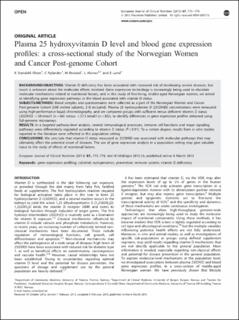| dc.contributor.author | Olsen, Karina Standahl | |
| dc.contributor.author | Rylander, Charlotta | |
| dc.contributor.author | Brustad, Magritt | |
| dc.contributor.author | Aksnes, Lage | |
| dc.contributor.author | Lund, Eiliv | |
| dc.date.accessioned | 2022-05-10T07:53:25Z | |
| dc.date.available | 2022-05-10T07:53:25Z | |
| dc.date.created | 2013-09-26T17:19:33Z | |
| dc.date.issued | 2013 | |
| dc.identifier.issn | 0954-3007 | |
| dc.identifier.uri | https://hdl.handle.net/11250/2994947 | |
| dc.description.abstract | Background/Objectives: Vitamin D deficiency has been associated with increased risk of developing several diseases, but much is unknown about the molecular effects involved. Gene expression technology is increasingly being used to elucidate molecular mechanisms related to nutritional factors, and in this study of free-living, middle-aged Norwegian women, we aimed at identifying gene expression pathways in the blood associated with vitamin D status.
Subjects/Methods: Blood samples and questionnaires were collected as a part of the Norwegian Women and Cancer Post-genome Cohort (500 invited subjects, 218 included). Plasma 25 hydroxyvitamin D (25(OH)D) concentrations were measured using high-performance liquid chromatography, and we compared groups with sufficient versus deficient vitamin D status (25(OH)D >50 nmol/l (n=66) versus <37.5 nmol/l (n=83)), to identify differences in gene expression profiles obtained using full-genome microarrays.
Results: In a targeted pathway-level analysis, several immunological processes, immune cell functions and major signaling pathways were differentially regulated according to vitamin D status (P<0.01). To a certain degree, results from in vitro studies reported in the literature were reflected in this population setting.
Conclusions: We conclude that vitamin D status measured as 25(OH)D was associated with molecular pathways that may ultimately affect the potential onset of diseases. The use of gene expression analysis in a population setting may give valuable input to the study of effects of nutritional factors. | en_US |
| dc.language.iso | eng | en_US |
| dc.publisher | Macmillan | en_US |
| dc.rights | Attribution-NonCommercial-NoDerivatives 4.0 Internasjonal | * |
| dc.rights.uri | http://creativecommons.org/licenses/by-nc-nd/4.0/deed.no | * |
| dc.title | Plasma 25 hydroxyvitamin D level and blood gene expression profiles: a cross-sectional study of the Norwegian Women and Cancer Post-genome Cohort | en_US |
| dc.type | Journal article | en_US |
| dc.type | Peer reviewed | en_US |
| dc.description.version | publishedVersion | en_US |
| dc.rights.holder | Copyright 2013 Macmillan Publishers | en_US |
| cristin.ispublished | true | |
| cristin.fulltext | original | |
| cristin.qualitycode | 1 | |
| dc.identifier.doi | 10.1038/ejcn.2013.53 | |
| dc.identifier.cristin | 1052784 | |
| dc.source.journal | European Journal of Clinical Nutrition | en_US |
| dc.source.pagenumber | 773-778 | en_US |
| dc.subject.nsi | VDP::Medisinsk genetikk: 714 | en_US |
| dc.subject.nsi | VDP::Medical genetics: 714 | en_US |
| dc.identifier.citation | European Journal of Clinical Nutrition. 2013, 67 (7), 773-778. | en_US |
| dc.source.volume | 67 | en_US |
| dc.source.issue | 7 | en_US |

